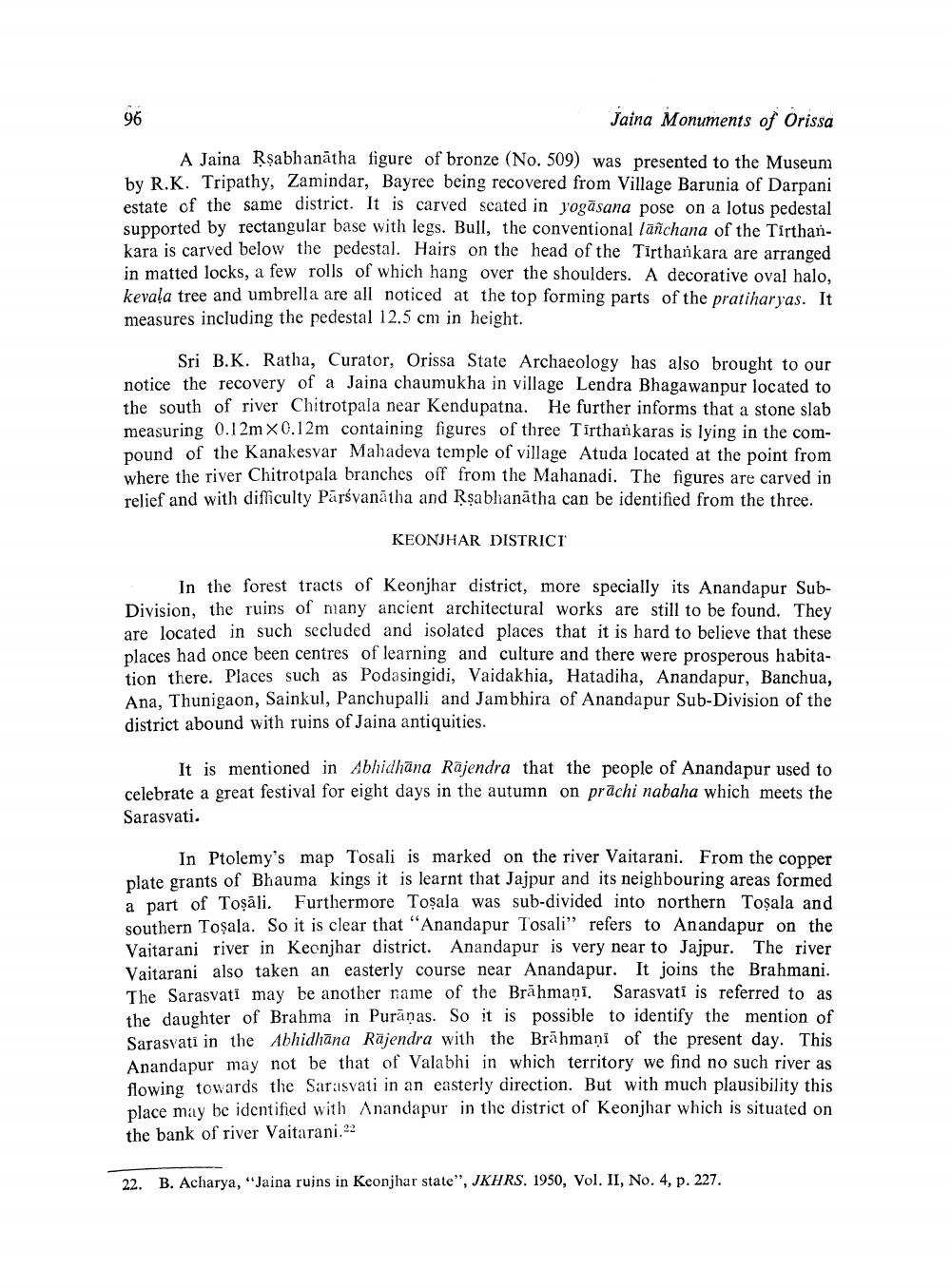________________
Jaina Monuments of Orissa
A Jaina Rşabhanātha figure of bronze (No. 509) was presented to the Museum by R.K. Tripathy, Zamindar, Bayree being recovered from Village Barunia of Darpani estate of the same district. It is carved seated in yogāsana pose on a lotus pedestal supported by rectangular base with legs. Bull, the conventional lāñchana of the Tirthankara is carved below the pedestal. Hairs on the head of the Tirthankara are arranged in matted locks, a few rolls of which hang over the shoulders. A decorative oval halo, kevala tree and umbrella are all noticed at the top forming parts of the pratiharyas. It measures including the pedestal 12.5 cm in height.
Sri B.K. Ratha, Curator, Orissa State Archaeology has also brought to our notice the recovery of a Jaina chaumukha in village Lendra Bhagawanpur located to the south of river Chitrotpala near Kendupatna. He further informs that a stone slab measuring 0.1 2m x 0.12m containing figures of three Tirthankaras is lying in the compound of the Kanakesvar Mahadeva temple of village Atuda located at the point from where the river Chitrotpala branches off from the Mahanadi. The figures are carved in relief and with difficulty Parsvanātha and Rsabhanātha can be identified from the three.
KEONJHAR DISTRICT
In the forest tracts of Keonjhar district, more specially its Anandapur SubDivision, the ruins of many ancient architectural works are still to be found. They are located in such secluded and isolated places that it is hard to believe that these places had once been centres of learning and culture and there were prosperous habitation there. Places such as Podasingidi, Vaidakhia, Hatadiha, Anandapur, Banchua, Ana, Thunigaon, Sainkul, Panchupalli and Jambhira of Anandapur Sub-Division of the district abound with ruins of Jaina antiquities.
It is mentioned in Abhidhana Rajendra that the people of Anandapur used to celebrate a great festival for eight days in the autumn on prachi nabaha which meets the Sarasvati.
In Ptolemy's map Tosali is marked on the river Vaitarani. From the copper plate grants of Bhauma kings it is learnt that Jajpur and its neighbouring areas formed a part of Toşāli. Furthermore Toşala was sub-divided into northern Toşala and southern Toşala. So it is clear that “Anandapur Tosali” refers to Anandapur on the Vaitarani river in Keonjhar district. Anandapur is very near to Jajpur. The river Vaitarani also taken an easterly course near Anandapur. It joins the Brahmani. The Sarasvati may be another name of the Brāhmaṇi. Sarasvati is referred to as the daughter of Brahma in Puranas. So it is possible to identify the mention of Sarasvati in the Abhidhāna Rajendra with the Brāhmaṇi of the present day. This Anandapur may not be that of Valabhi in which territory we find no such river as flowing towards the Sarasvati in an easterly direction. But with much plausibility this place may be identified with Anandapur in the district of Keonjhar which is situated on the bank of river Vaitarani.22
22. B. Acharya, "Jaina ruins in Keonjhar state", JKHRS. 1950, Vol. II, No. 4, p. 227.




